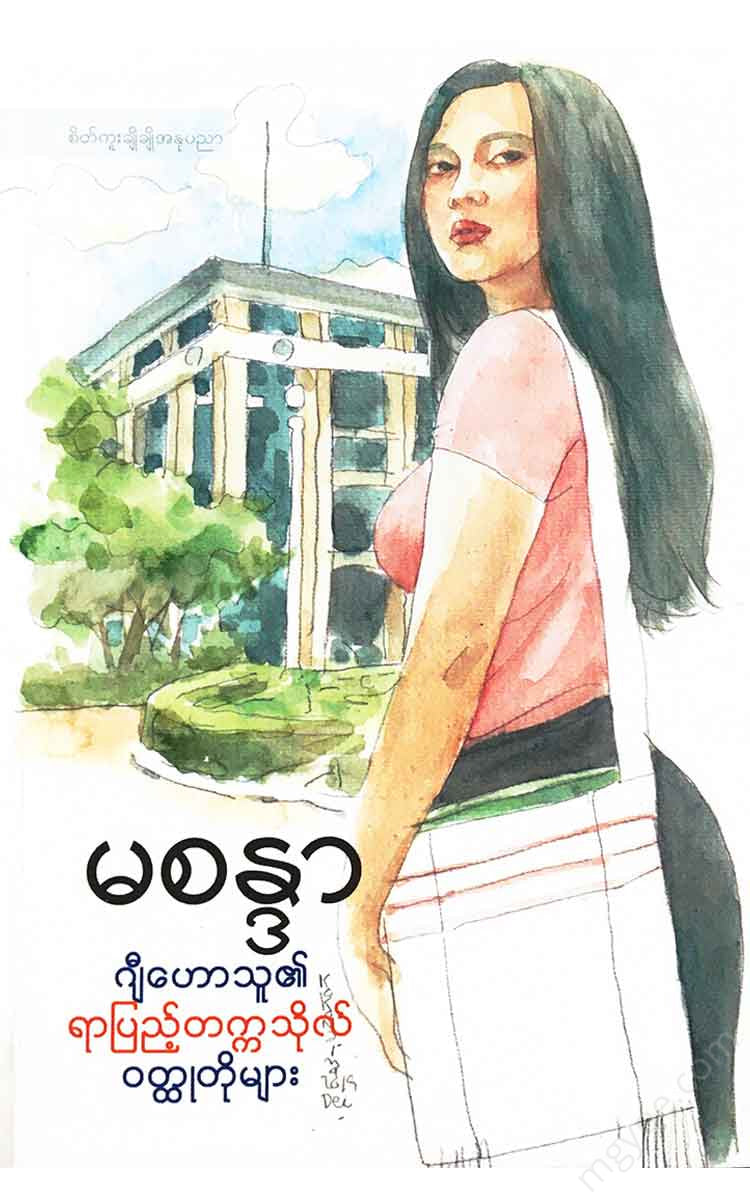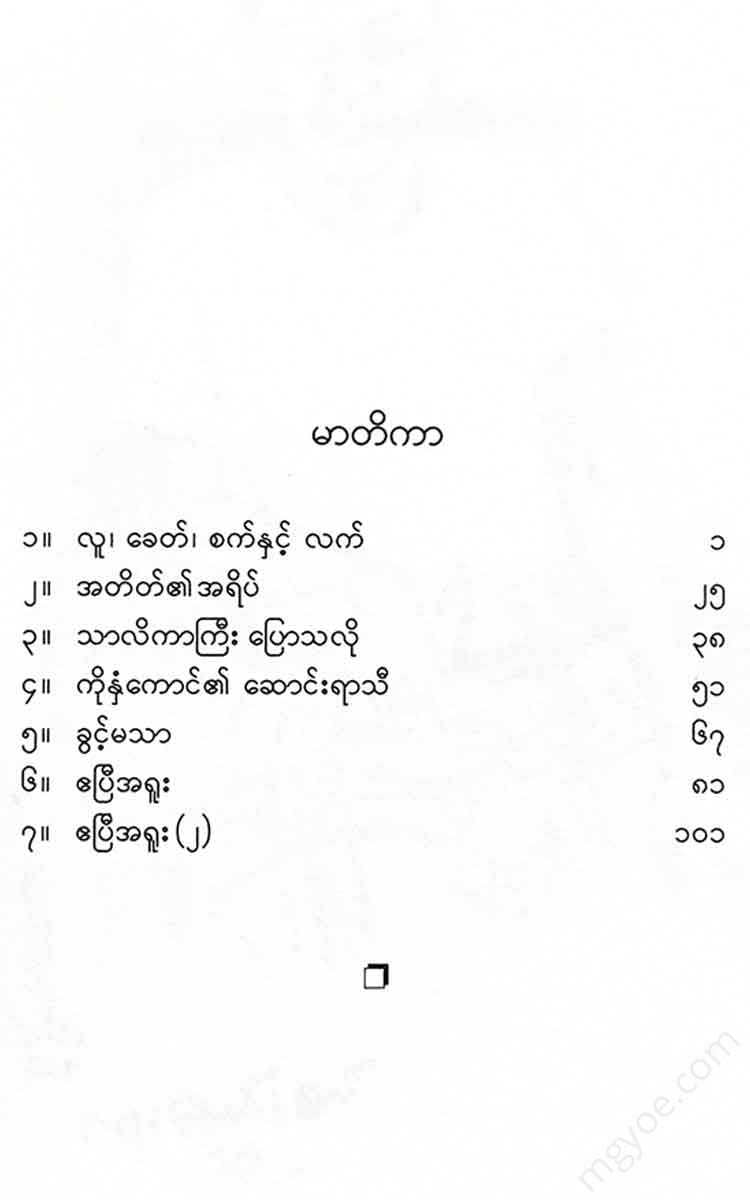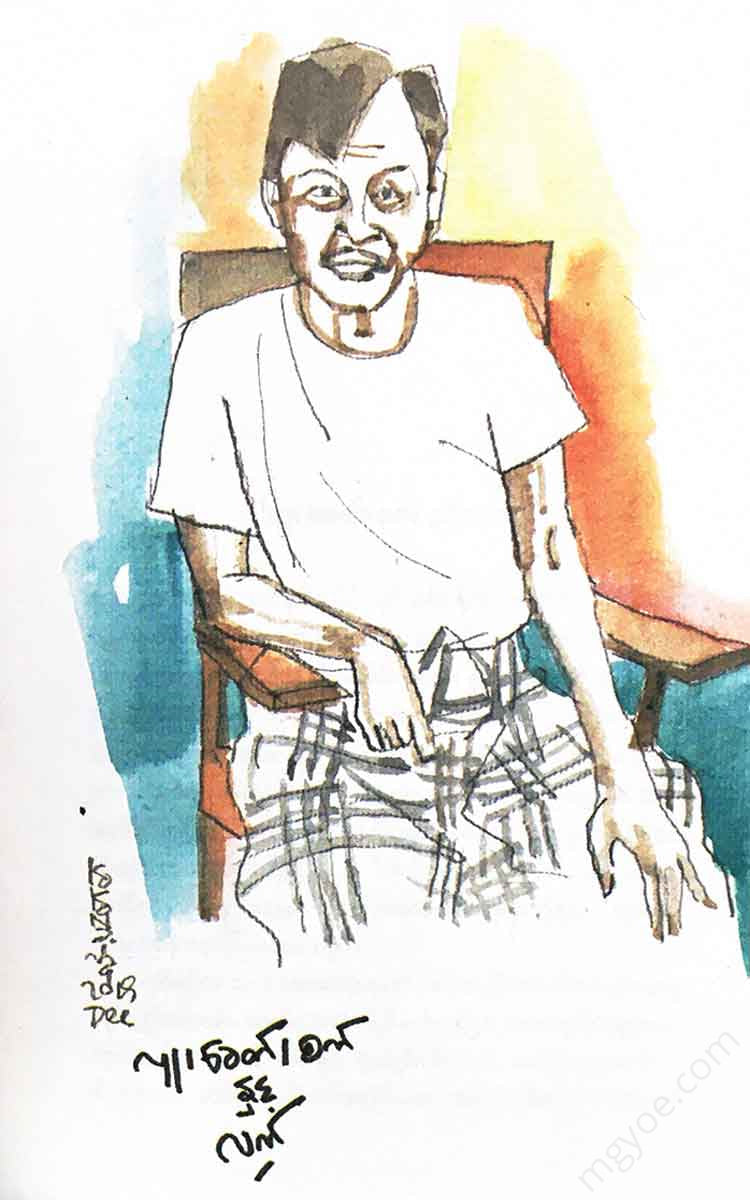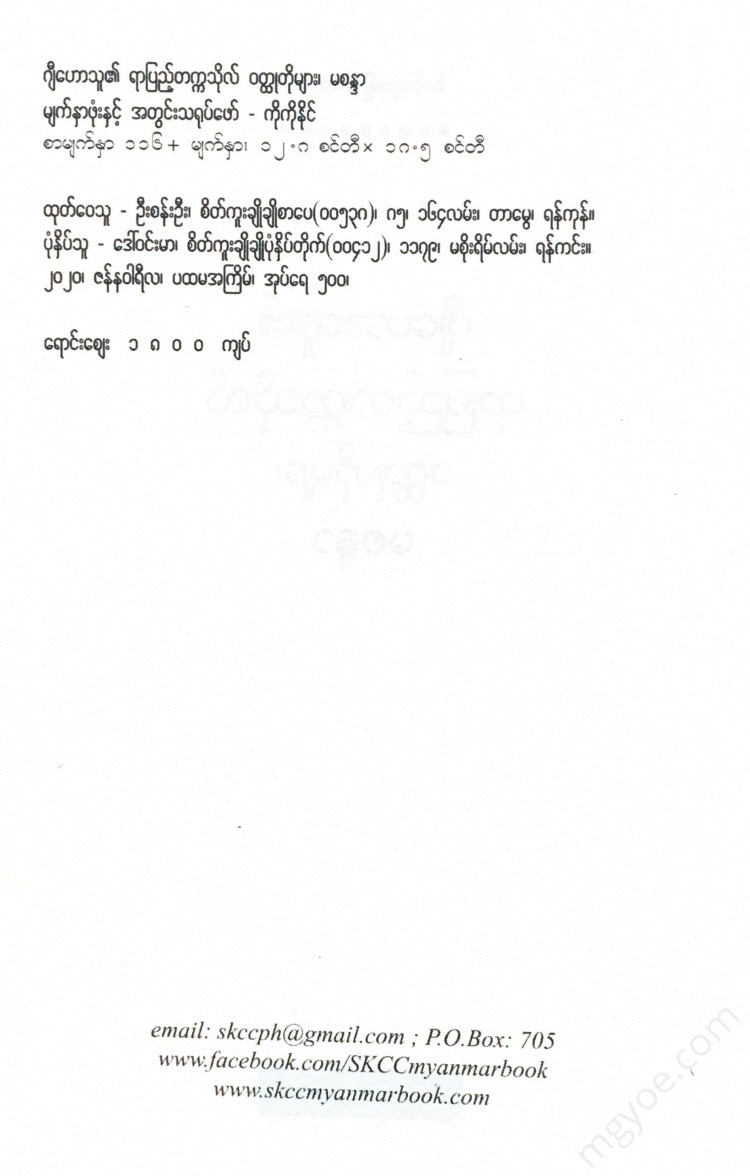စိတ်ကူးချိုချိုစာပေ
Masandar - Jihatu's Centenary University Short Stories
Masandar - Jihatu's Centenary University Short Stories
Couldn't load pickup availability
1965, 36 years ago. More than twenty students who were eligible to study architecture arrived at the Yangon Institute of Technology with their eyes and ears wide open. They were naturally overwhelmed by the grandeur of the building and the energy of the students who were moving here and there, holding their slide rules and books. Sitting in the classroom, they wondered, “What kind of skills and methods should we teach and learn?”
At that time, even the carpenter, the sculptor, and even the one who painted the princes, princesses, and landscapes on the leather bags of Burma were collectively called architects. Architecture was not considered a skill that had to be learned step by step after six years of university. They still did not say, “Architecture is an art.”
Although all of them are collectively called engineering, there are many different types of engineering professions. There are different specializations such as industrial, civil, chemical, mining, textile and textile, etc. The population is also large. Architects are a minority. .
In the first semester, all students (including architecture students) are taught in a multi-lingual manner. Therefore, students can carefully study the specializations they have chosen during the first year of study and decide whether they are suitable for them. If they feel that the specialization they have chosen does not match their interests, they can apply to change in the second semester.
We, the architecture students, were also walking along the sidewalk in front of the architecture department. We went to see the head of the department, Professor U Myo Myint Sein, from a distance. We were afraid to get close. As we watched the senior students drawing designs and making small models, we wondered, “Can we do this kind of work?”
Myanmar's first female architect, Daw Thin Thin Aye, is in her sixth year. She is pale and slender and wears high heels. Among the women, there is Khin Khin Kyu in her fifth year and Thin Thin Aye Phe in her fourth year. The third year is special. It has only one student. It is "Sai Ri Leik", a Shan national.
All the students called Sai Ri Leik “Ko Leik”. Everyone loved Ko Leik because of his soft spoken, sweet face, and handsome appearance. At that time, his studio master (class teacher) was Sayar Kyaw (Dr. Maung Kyaw). The teacher often had to look for the student who was sleeping in the dormitory instead of coming to school. Sayar Kyaw would come into our drawing room and look around. Then he would ask, “Hey.. haven’t you seen a Sai Ri Leik?”
I watched with interest the people in the drawing rooms called studios, drawing with tri-squares, squared squares, and triangles, and wondered, "But... what kind of buildings are they drawing with what thoughts?"
At that time, a high-ranking government official was rumored to have said that Burma did not need many architects, and that one was enough. At that time, Burma was a country that was moving towards socialism, and it was true that the construction of beautiful houses, shopping malls, hotels, and restaurants was not a priority.
Whether that person really said that or not, we still don’t know for sure. However, it caused a great deal of confusion among us young architects. Let alone those who have become architects and those who will become architects before us, there were 22 new entrants in our school year, or 25 if we add up the three-year-olds. What would they do if they succeeded? In a socialist country, they wouldn’t dare to think of starting their own architectural practice. For engineers, there are two main paths: working as a staff member by subject, or by ship if they don’t. For architects, there is no other choice but to join the construction corporation. If there is one person in the whole country, it is enough, and architects are burned out. We shouldn't blame those who are worried about being unemployed after studying hard for six years and graduating.
When the second semester arrived, some of us, 25 first year students, had to drop out twice. Some decided to change to engineering subjects. We, on the other hand, were quite happy, thinking, “Next time, next time, it’s the same price. We will walk the chosen path to the end, whether it’s thorny or flowery.”
Two talented people who are not afraid of unemployment also emerged. They are Ko San Maung and Phyu Phyu Lat. They changed their studies from engineering to architecture.
In the second semester, we had not yet drawn a single building. We studied the shape and composition of objects, light and darkness, the direction of light and shadows, the nature of color, the composition of combinations, the texture of surfaces, etc., and the history of architecture in the world and Burma. These subjects were taught by the head of the department, U Myo Myint Sein, and the great Russian teachers, Mr. Ojigor and Mr. Rodionov (Father).
At that time, a volunteer teacher arrived. Architect Khin Maung Yin. He made us understand not only light and dark and color, but also the various shapes formed by lines. He never thought about it. He only taught us to think. He would always say, “Just draw, and you will know if it is good or bad.” The habit of drawing and comparing from time to time became ingrained in me, and even now, my drawings, writing papers, and other writing materials are all one big pile.
Here I would like to talk a little about “Khin Maung Yin”. “Khin Maung Yin” was our teacher, but no one called him “teacher”. He also did not like the term “teacher”. When he spoke about himself, he rarely used pronouns such as “I.... I... you... we... etc. He would even include his name and say “Khin Maung Yin Ka” or “Khin Maung Yin Ka”. Therefore, we no longer called each other “Ko Khin Maung Yin” or “U Khin Maung Yin” but “Khin Maung Yin” as friends. His thoughts, ideas, style of speaking, and even the way he would gently brush his hair that fell on his forehead with his right hand, influenced many architecture students. What was special was that not only the students but also the students loved him dearly and openly. He only taught the students of the classes of (63-64) and (64-65), and he often visited us when our senior class was away. He stopped coming to school when we were about to finish school.
He is an architect, but not a professional architect. He has directed and made a few films, including the film “My Sister Is Not Giving Up,” but it is not commercial. He paints. He sells if there is a buyer, but he does not draw to sell. He is also said to have studied etiquette, but he is quite proficient. However, he only looks and speaks well when he feels like it. Sometimes he pushes away an outstretched hand and says, “It’s just a free cup.” “A cup” means “a dog’s hand.” He would look at a student’s hand carefully and say, “You study, graduate, get a wife, work, and then grow old and die. That’s all there is to it.”
Once, I boldly held out my hand in front of him and said, “Let me see.” I thought it was because I was still in a good mood. He said, “Let me see,” and took both of my hands and looked at them intently. Then, without saying anything else, he said, “You... when you grow up, you will be as famous as Wa Wa Win Shwe in the field of art.” At that time, I was still writing short stories for the university section of “Ngwe Taree Magazine.” “Wa Wa Win Shwe” was already a famous movie actress. I didn’t believe her words, but I was very happy. Before she passed away, I met her at an architectural competition and she was happily saying, “Writer, writer.” My friend Ko Ye Myint said, “Khin Maung Yin taught me..., remember, I was so happy that I jumped up and down with joy at that time.”
In the years before her death, she lived in a small alley in North Okkalapa. At first, she taught English to children in the neighborhood. However, later, due to her poor health, she stopped teaching. Although she did not visit her often, there was no one who did not visit her, and she always went to her out of love. Even those who had settled abroad would often visit her whenever they could when they returned to Myanmar.
The house he lives in is like a big tent. When he was teaching the children, there were desks, but later on, only paintings took up space. The whole room was filled with paintings, paintings in progress, and paintings in preparation for painting. The floor was so thin that the shoots of the thorny plants growing in the mud under the house crept through the gaps and made holes in the house. There was no bed, but he slept on a mat on the floor. He never put up a mosquito net, and if there was a mosquito net, he would put a towel in the hole. There was a young man who helped him with his chores. For food, his sister, who lived nearby, said that she would send him a bowl of rice.
He had no desire for wealth, position, fame, honor, or fame. He lived in the human world as he pleased.
In the third year, we moved on from colors, curves, and straight lines. The first thing to think about was the guide post. We had to think about including a marker for the area we were going to guide. They said they wouldn’t accept a guide post with an arrow on it and “to Yangon.” They allowed us to imagine and design any area we liked.
Our trainees also guided each other with their own ideas. As far as I remember, the Inle guidepost was designed by Morin Cho, a young Inle boy wearing a helmet, rowing a boat with his feet. Khin Swe Su drew the Kachin Land guidepost with Manaw poles. Ko Nyunt Myat guided the village of Kyaukka with a small alms bowl.
Our class teacher, Mr. Oji Do, was particularly impressed by the fact that lacquerware was made in Kyaukka village. I was guided by the large coins excavated in the old city of Vishnu, representing the ancient coins and writing Vishnu on the large round coins. I still remember that Khin Thein Win was the one who guided us to Chauk City using the large oil tank. The one who guided us to Mandalay with the polished pillar and gold letters was “Hla Hla Myint”.
When the guide post was designed, we were asked to copy and draw house models from books. We were told to draw just for the sake of drawing, but we didn't know why. However, as we copied and drew, we gradually came to understand the size, position, and proportions of the rooms in a house.
After a few rounds of discussions, we were asked to design a rest house. We were allowed to choose any location we liked. We, the aspiring architects, started to think about various ideas, like a house we would actually own and live in.
He thought about building in stages on a low slope, he thought about climbing the mountain, he went to the seashore, he went to the confluence, he built a floating house in Inle Lake, he went down to the valley near Pyin Oo Lwin, he put down the drawing paper and pencils whenever he felt like it. Some had a pointed roof, some had a flat roof, some had a curved roof, someone wanted to see the sun and the moon freely, and he planned to cover the roof with glass panels and scattered them as he thought. When I got older, I remembered the times when I was young.
After much thought and deliberation, we finally came face to face with the dreaded jury on the day of the presentation.
The jury is the one who has to present his design in front of all the teachers in the architecture department. If the teacher asks, “The place you have chosen is a place where there is a lot of rain, is it okay to use a flat roof?”, he should be able to answer by saying, “Although the roof is flat on the outside, it will be lowered three inches from the center to the left and right sides, so that the rain will easily run off. There are enough rain gutters on all four sides, so that the rain that falls will immediately fall to the ground. The concrete roof will also be protected with modern methods to prevent rain from leaking.” The teachers also evaluate not only the design he has produced, but also his manner of speaking and presenting. I hope the design he has presented is good, but I can’t say it clearly, so I rub my nose and sniffle in fear, Even if you just scratch your head, you're not sure you'll get a good score. This is our first experience with such a famous "jury," so everyone is excited and nervous.
While we were all so scared, a very funny incident happened. The creator was Ko San Maung, and the bearer was a tall, slender, and handsome man from Mandalay. He was quite small, but he had a beautiful face and a dark complexion. He spoke very clearly and was not sure about his nose, so we were very excited.









